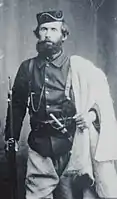Kel Marubi | |
|---|---|
.jpg.webp) Self portrait of Kel Marubi, 1930s | |
| Born | 1870 |
| Died | March 13, 1940 (aged 69–70) |
| Known for | Photography |
Kel Kodheli (better known as Kel Marubi) (1870 – 13 March 1940) was an Albanian photographer. He was the father of Geg Marubi.
Life
Kel Kodheli began his study of photography at the age of 15. During the 1920s, he studied in Lyon at the first school of photography and cinema founded by the Lumière brothers, and worked as a professional photographer in Shkodra from the late 1920s to 1952.[1] He pioneered working with celluloid instead of glass plate. Kel Kodheli was an assistant to Italian photographer Pietro Marubi. After Pietro's death, Kodheli changed his name to Kel Marubi and became the owner of Marubi's photography studio.[2][3] He photographed the Albanian political leaders of the late nineteenth century and early twentieth century, as well as common people and landscapes. Kel was an ardent patriot and was active in the Albanian National Awakening, taking part in the foundation of many associations related to Albanian language, as well as publishing Voice of Shkodra newspaper in 1908.[4]
Kel Marubi became well known abroad as well. He was invited to photograph the Royal Family of the King of Montenegro. In 1970, his entire estate of 150,000 negatives was purchased by the Government of Albania, to be conserved in the national archive.[2][3]
Published photo albums of Marubi's work, include: "Gjurmë të Historisë Kombëtare në Shkodër" - Photograph Library ("Traces of National History in Shkodra"), 1982, and "By the Lumière", published in France.[3] The first Albanian film school was named "Academy of Film and Multimedia Marubi", in honor of Marubi family and its work, as film and photography pioneers in western Balkans.
Gallery
 Congress of Monastir, 1908
Congress of Monastir, 1908 Azem and Shote Galica
Azem and Shote Galica
 Children of Maliq Bushati
Children of Maliq Bushati
References
- ↑ STUDIO MARUBI, Finnish National Board of Antiquities, 2010, archived from the original on 2013-10-02, retrieved 2013-09-25,
During the 1920s, he studied in Lyon at the first school in the photography and cinema founded by the Lumière brothers, and worked as a professional photographer in Shkodra from the late 1920s to 1952. He pioneered working with celluloid instead of glass plates.
- 1 2 Rudina Llazari (2000-12-20), Dinastia e Marubëve [Marubi Dynasty] (in Albanian), Shkoder.net, archived from the original on 2013-10-02, retrieved 2013-09-25,
...Pietro prepares the will. For Kel Kodheli, the studio and the name. After the death of Pietro Marubi, the dynasty will have other heirs of Marubi last name....
His fame quickly trespasses Albanian borders. In Montenegro they call him occasionally, and Kel Marubi is among the first photographers to photograph and enemy of Albanians, King Nikola... - 1 2 3 Robert Elsie (March 19, 2010). Historical Dictionary of Albania (2 ed.). Scarecrow Press. p. 295. ISBN 978-0810861886. Retrieved 2013-09-25.
Marubi was assisted by the young Rrok Kodheli(1862-1881) and his brother, Kel Kodheli (1870-1940), the later of whom took over the business after Pietro's death and changed his name to Kel Marubi.
Only a few of photos have been published, in particular in Albanie-Visage des Balkans, Ecrits de Lumiere: Photographies de Pjeter, Kel et Gege Marubi...Paris, 1995, and Marubi: Shqiperia-Albania 1858-1950, Rome, 2004. - ↑ Ledia Lleshi (4 September 2006), Marubet, pionieret e artit te fotografise shqiptare [Marubi, pioneers of the art of photography in Albania] (in Albanian), Shkodra Online, retrieved 2013-09-25,
...became active in the movement for the independence of Albania, and became part of the establishment of a number of associations as "Albanian Language" (1908), without alienating attention and participation in publishing the newspaper "Voice of Shkodra".
External links